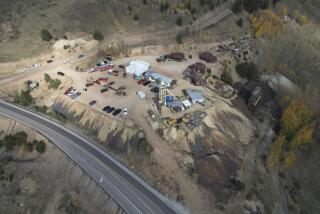Too Few Elevator Inspectors
- Share via
Spend time with Raul Gras and you may understand why people aren’t lining up for his job.
Gras is a city elevator inspector, a valued asset in a department that has tried for months to hire new inspectors with little success, and has fallen behind as a result.
Gras dwells in a strange underworld of the city, braving rats in the narrow spaces beneath 30-story buildings, sweet-talking gang members on rooftops, and infiltrating the inner workings of office towers as he glides up and down through 100-foot shafts.
“It’s kind of a lonely job,” said Gras, whose shirt pockets are packed with small flashlights and pressure gauges. “It’s just you, the radio in your car, and your paperwork. . . But you never know what to expect. You’ve always got to be on your toes.”
Gras claims to love the work. But even he admits it’s tough and dangerous. Add to this the fact that elevator experts such as he occasionally command six-figure salaries in the private sector, and it becomes clear why it’s so hard for the city to attract qualified inspectors, said Lance Wong, L.A.’s chief elevator safety engineer.
Elevator inspections are eight to 10 months behind schedule as a consequence, Wong said. The city has just nine inspectors to examine roughly 21,000 elevators and escalators in the city each year. Without more inspectors, Wong said, the unit can’t catch up.
Although city inspectors were recently granted 8% raises, boosting their salaries to between $50,000 and $61,000 yearly, it’s taken months for Wong to fill just one of four openings.
“It’s a very good time for the elevator industry, and mechanics are needed,” Wong said. “So they want to get a piece of the pie before it’s over.”
The story is very similar for the California division of the Occupational Safety and Health Administration, which conducts inspections for the rest of the state’s 78,000 elevators. (Los Angeles is the only city in the state to have its own elevator inspectors because the city’s inspection program was started before the state’s--back in 1896--and was grandfathered into the state law.)
“We are having the same problem,” said James Meyer, principal engineer for the elevator unit of OSHA. The state is also behind on inspections, with some occurring six months behind schedule, he said. Meyer said the state recently began advertising in national journals in a bid to lure inspectors from out of state.
“There’s not a lot of people out there,” Meyer said. “We are trying to draw people out of industry, where they are making $80,000 to $100,000, and asking them to take a pay cut to $50,000. Most don’t want to do that.”
Keeping the city’s inspection program up to date is important for public safety, Wong contends, even though it’s rare for inspectors to find serious problems with elevators.
Of the more than 20,000 elevators the city has inspected in the past year, just 114 were found to be so faulty they were taken out of service, most just temporarily, he said. Of the 44 accidents reported to the unit so far this year, none had to do with elevator mechanics. Most involved someone tripping and falling on an escalator.
Still, Wong said, the surprise inspections motivate building owners and mechanics to keep elevators in good condition. Time-consuming inspections of new elevators, which include “crash tests” in which inspectors drop the new elevator all the way down the shaft, help stave off potential problems.
“Most people think the elevator is just a magical device--you press a button and it goes,” said Gras, 42. “. . . But you can never assume.”
Wednesday’s inspection was a case in point. Gras, senior inspector downtown, was called to a building in the Mid-Wilshire area. After ascending to the roof of the building and checking a mechanism inside the building’s “penthouse”--a small shed containing elevator machinery--Gras was feeling hopeful.
The elevator appeared to be in good shape. The electronic gadgetry wasn’t throwing off sparks, there were no oil leaks, no signs that someone had patched up the wiring. Gras checked the “governor”--a device that makes sure the elevator doesn’t fall too quickly--and the earthquake system, that ensures that if the building shakes, the elevator simply moves to the closest floor, opens its doors, and freezes.
“Very clean,” he murmured.
But later, after stopping the elevator between floors, and stepping gingerly out on its roof, things went awry. Instead of the elevator lowering itself slowly at his command as it was supposed to, it suddenly dropped at normal speeds--350 feet a minute--while Gras scrambled for the emergency “stop” button.
Gras emerged from the shaft a few minutes later, looking as calm as ever except for his hands, which were compulsively twisting a grease-stained rag.
“This is why I used to have hair,” he joked, stroking his waning hairline.
When new construction began to pick up in recent years, and demand for elevator upgrades kicked in, the growth in the ranks of elevator mechanics didn’t quite keep pace, said Dana Brigham, of the International Union of Elevator Constructors, a Maryland-based organization with 23,000 members.
“We are training a lot of new folks, but it takes five years,” he said. In the meantime, the union has encouraged its Canadian members to cross the border to fill openings in the eastern United States.
The glut of work is coming not just from new construction, but from improvements in elevator technology that are prompting many building owners to upgrade their systems, said Ed Miller, president of Golden State Elevator Co. in Van Nuys.
Elevator mechanics are “a top trade,” said Miller, who confirmed that those willing to work a lot of overtime can earn salaries in excess of $100,000.
Building owners find it easier to attract tenants with speedier elevators, and are increasingly willing to pay the price for the newest equipment, he said.
More to Read
Sign up for Essential California
The most important California stories and recommendations in your inbox every morning.
You may occasionally receive promotional content from the Los Angeles Times.













